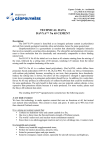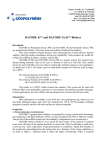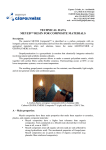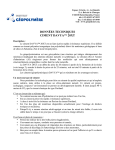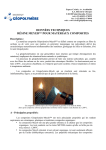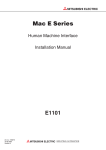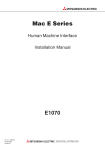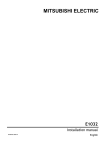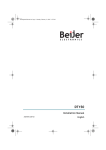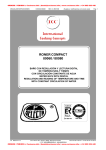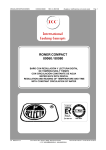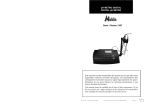Download Davya 60 Properties - Geopolymer Institute
Transcript
Espace Créatis, Av. Archimède Z.A. Bois de la Chocque F-02100 Saint-Quentin, France tel:(+33) (0)323 67 8922 fax: (+33) (0)323 67 8949 web : www.geopolymer.org TECHNICAL DATA DAVYA™ 60 CEMENT Description: The DAVYA™ cement is described as an inorganic polymer cement (a polysialate) derived from natural geological materials silica and alumina, hence the name geopolymer. Geopolymerization is a geosynthesis (a reaction that chemically integrates minerals) that involves naturally occurring silico-aluminates. The silicon(Si) and aluminium (Al) atoms react to form molecules that are chemically and structurally comparable to those binding natural rock. For DAVYA 60 the initial set is as short as 60 minutes starting from the mixing of the resin, followed by a setting time of 25 minutes, totalising 85 minutes from the initial mixing until the complete hardening of the resin. The resulting DAVYA™ (geopolymeric) cements have the following assets: A new kind of cement We have the technology to make superior cement that uses no limestone at all, but instead uses natural silico-aluminate. This cement is clean and green. It emits up to 90% less CO2 than classical Portland cement. It is a strong an resistant cement that: • Contains no hydration water and cannot explode in a fire, • Has two to three times the flexural/tensile strength of Portland cement, • The world’s safest toxic and nuclear waste-containment material • Since there is no alkali-aggregate reaction and very low shrinkage rate, it cannot crack. It is beautiful and versatile: • Makes very beautiful reagglomerated stone, • Perfect for interior decoration, attractive tiles, • Suited to pressured pipes and pipe tunnels, • Suited to emergency repair cement, especially for aircraft runways and highways, • Good for marine uses because no salt cannot affect it and it goes hard underwater within 2 hours. • Suited for extremely cold temperature (it sets at –20°C). It is economic: • You do not need to re-equip your factory, • You save two thirds of your fuel, • You can make cement outside limestone regions. Information: More information is available in our Web site www.geopolymer.org, where you can download additional papers and order the Géopolymère ’99 Proceedings including numerous scientific articles with tests and data on selected materials. Properties: DAVYA™ Cement does not use limestone as a material. Instead, it uses special kaolinite-based clays. The calcining temperature for this cement is approximately 750°C. This means that two thirds of fuel normally used for Portland cement production can be saved. This cement has many special properties that can resolve many long-standing problems which have plagued Portland cement-based concrete. Therefore, it has attracted increasing attention. The following diagrams illustrate some of the main properties of DAVYA™ (geopolymeric) cement. 1. High early strength Figure 1. Comparison of early strength between DAVYA™ cement and Portland cement setting at room temperature. 2. Low shrinkage rate Figure 2. Comparison of shrinkage rate. 3. Resistance to corrosion Since no limestone is used as a raw material, DAVYA cement has excellent properties within both acid and salt environments. It is especially suitable for tough environmental conditions. Sea water can be used for the blending of the cement rather than fresh water. This can be useful in marine environments and on islands short of fresh water. (It is impossible to make Portland cement with sea water). Figure 3. Comparison of resistance to corrosion between DAVYA cement and Portland cement. After 28 days’ standard setting, samples were put into 5% sulfuric acid solution, and the weight loss was measured. 4. Very high fire-resistance properties Since there is no hydratation water in DAVYA™ (geopolymeric) cement, it will not explode under high temperature. It can thus be used for tunnels and high-rise structures as a fire-prevention measure. For existing tunnels and high-rise structures, a 30 mm cladding of DAVYA cement will render them fire-resistant. Figure 4. Comparison of strength of DAVYA cement-based concrete with high performance Portland cement-based concrete (Pyrament) and ordinary Portland cement-based concrete (type I and III) under high temperature. The DAVYA cement-based concrete was kept at a temperature of 1000°C for three hours and still had a compressive strength of approximately 30 MPa. On the opposite, Portland cement-based concretes explodes and deteriorates at 300°C. 5. High flexural strength The ratio of compressive strength to flexural strength of normal Portland cement is about 10. The ratio for DAVYA is about 5. Some DAVYA (geopolymeric) cement can even reach 3.5. Therefore, for the same compressive strength, the flexural strength of DAVYA is two to three times higher than it is for Portland cement. Figure 5. The comparison of compressive strength and flexural strength for DAVYA 6. No alkali-aggregate reaction DAVYA cements even with alkali contents as high as 9.2% or higher do not generate any dangerous alkali-aggregate reaction. But in Portland cement, even alkali contents as low as 1.2% are dangerous. Figure 6. Alkali-aggregate reaction: ASTM C227 mesures the linear expansion DAVYA cement and ordinary Portland cement. 7. Clean and green Another reason for DAVYA attracting attention today is that during its production, the carbon dioxide emissions for the same weight of cement as Portland is only 15%-20% of that of Portland cement. The production of one ton of Portland cement emits one ton of carbon dioxide into the atmosphere. Huge quantities of cement production seriously threaten the world’s environment. Based on the continuity of development, especially in the developing countries, the use of DAVYA cement to reduce the burden on the atmosphere is highly necessary. Society benefits from cement production, but the cement industry has a responsibility to leave a sustainable atmosphere for future generation. 8. Technical Data Sheet for DAVYA™ geopolymeric cement type (Potassium, Calcium)Poly(sialate-siloxo) / (K,Ca)-(Si-O-Al-O-Si-O-), Si:Al=2:1 These indicative data are only disclosed for a standard DAVYA binder, and may vary for more or less 25%, depending on the quality of the binder, its fillers, the manufacturing conditions of your sample, … Tested on standard sand mortar prisms: • setting: 20 hours at -20°C to 60 minutes at +20°C. • shrinkage during setting: <0,05%, not measurable. • compressive strength (uniaxial): > 75 MPa at 28 days. • flexural strength: 11-14 MPa at 28 days. • Young Modulus: > 2 GPa. • freeze-thaw: mass loss < 0,1% (ASTM 4842), strength loss < 5% after 180 cycles. • wet-dry: mass loss < 0,1% (ASTM 4843). • pH: crushed and powdered, 11-11,5 after 5 minutes in deionized water (compared to Portland cement: 12 to 12,5, and granit: 11). • leaching in water, after 180 days: K2O < 0,015%. • • • • • • • • • • • • • water absorption: < 3%, not related to permeability. hydraulic permeability: 10-10 m/s. Sulfuric acid, 10%: mass loss 0,1% per day. chlorhydric acid 5%: mass loss 1% per day. KOH 50%: mass loss 0,02% per day. ammoniac solution: no mass loss. sulfate solution: shrinkage 0,02% at 28 days. alkali-aggregate reaction: no expansion after 250 days, -0,01% (compared to Portland Cement with 1% Na2O, +1,5%). linear expansion: < 5.10-6/K. heat conductivity: 0,2 to 0,4 W/Km. specific heat: 0,7 to 1,0 kJ/kg. electrical conductivity: strongly dependent on humidity. thermal stability: - mass loss < 5% up to 1000°C. - strength loss < 20% at 600°C, < 60% at 1000°C Other values: • D.T.A.: endothermic at 250°C (zeolitic water). • MAS-NMR spectroscopy: - 29Si: SiQ4, major resonance at -94,5 ± 3ppm. - 27Al: AlQ(4Si), major narrow resonance at 55 ± 3ppm. • Energy consumption: SEC for cement 1230-1310 MJ/tonne (compared to Portland clinker 3500 MJ/tonne). • CO2 emission during manufacture: 0,180 t/tonne of cement (compared to Portland clinker 1,0 t/tonne). Mode d’emploi DAVYA 60 ™ Directions for use DAVYA 60 ™ Ce mode d’emploi s’applique à la fois à la DAVYA pour une utilisation classique et comme matériau d’inertage de déchets toxiques (DAVYA Waste). Nous vous montrons ici la méthode la plus simple d’utilisation à la main. Il va de soi que l’utilisation de machines de laboratoire facilite la mise en œuvre. Le manipulateur devra utiliser une blouse et des gants, et respecter les conditions d’hygiène et de sécurité qui s’applique à son laboratoire. Le manipulateur sera assisté d’une personne chargée de nettoyer immédiatement les ustensiles à l’eau avant le début de la prise. Vous pouvez conserver ce kit DAVYA pendant 6 mois. La DAVYA 60 a un début de prise de 60 minutes à partir de la formation du liant (voir image 3), ensuite la durée de prise est de 25 minutes, soit 85 minutes à partir de la formation du liant à température ambiante (20°C). La vitesse de prise dépend de la température de la pièce. Le début de prise des liants DAVYA 60 est mesuré à température ambiante, c'est-à-dire 20°C. Si votre laboratoire a une température ambiante plus élevée (par exemple durant l'été, ou si vous n'utilisez aucun système d'air conditionné), le temps de prise sera plus court. À 25°C, le début de prise de la DAVYA 60 devrait être de 47 minutes. Pour ralentir ce temps de prise, nous suggérons que vous réalisiez votre expérimentation tôt le matin ou vous devriez stocker la poudre, le durcisseur et la charge pendant 1 heure au réfrigérateur. This DAVYA user’s manual describes the manufacture of a high-strength cement and a material that encapsulates toxic wastes (DAVYA Waste). We show here the easiest method to do it. It is obvious that the use of laboratory equipments makes the operation easier. The lab. technician should use overall and gloves, and respect the the safety and security rules that apply to his laboratory. He may be assisted by a second technician in charge of cleaning the tools, immediately in water, before the hardening of the binder. You can store this DAVYA kit for 6 months. Voici le mode d’emploi pour une utilisation simple de la DAVYA : 1 - Préparez 4 parts en poids de poudre (partie A), 3 parts en poids de durcisseur (partie B) et entre 50 et 200% de charge selon la granulométrie. 2 – Versez le durcisseur dans la poudre. 3 – Mélangez à la machine ou à la main jusqu’à obtenir une résine fluide. 4 – Versez la résine dans la charge. 5 – Mélangez le tout. Ici nous utilisons une machine vibrante pour faciliter le mélange à la main. 6 – Coulez le mélange dans un moule hermétiquement fermé. Laissez durcir 24 heures. Pour accélérer la prise, si nécessaire, laissez d’abord durcir 2 heures à température ambiante (afin que la réaction chimique se réalise complétement), ensuite placez le moule dans un four à 60°C pendant 2 heures. 7 – L’outillage se nettoie très facilement à l’eau lorsque le mélange n’est pas encore durci. 8 – Une fois durci, placez l’échantillon dans un sac plastique hermétiquement fermé ou plongez-le dans l’eau, et gardez-le ainsi au moins pendant 28 jours à température ambiante pour une prise optimale. Notez la couleur noire-verte de l’échantillon pendant le premier jour (c’est le signe d’une bonne géopolymèrisation). 9 – Après 28 jours, sortez l’échantillon du sac et remarquez que la couleur est redevenue normale. Maintenant, vous pouvez faire subir des tests à cet échantillon. L’échantillon de DAVYA Waste ne change pas de couleur, car la charge de couleur noire à colorée la DAVYA. L'utilisation d'une charge est obligatoire, sinon le liant DAVYA se fissurera. Contrairement au ciment Portland qui, utilisé sans charge a du retrait, la DAVYA n'a pas de retrait mais se fissure. Vous observerez cette caractéristique au sommet de votre échantillon à l'endroit où la charge a décanté. Nous retirons toujours mécaniquement cette couche fragile avant de faire nos tests. Le Client accepte que Institut Géopolymère ne délivre aucune garantie, exprès ou implicite, incluant de manière non limitative les garanties légales et commerciales et autres certifications, concernant la chimie des géopolymères et son utilisation, sa fabrication et sa commercialisation, seule ou associée aux produits du Client. En aucun cas, même en cas de force majeure ou cas fortuit, Institut Géopolymère ne sera responsable des dommages directs, indirects, spéciaux ou consécutifs survenant de l'utilisation, fabrication, distribution ou vente des produits du Client ou faites par une tierce partie. For DAVYA 60 the initial set is as short as 60 minutes (starting from the mixing of the binder as displayed in picture 3), followed by a setting time of 25 minutes, totalising 85 minutes from the initial mixing until the complete hardening of the binder at room temperature (20°C). The setting time depends on the room temperature. The initial set for DAVYA 60 is measured at room temperature, namely 20°C. If your laboratory has a higher room temperature (for example in summer time, or you do not use any air conditioning system), the setting time will be shorter. At 25°C, the initial set for DAVYA 60 may be 47 minutes. To slow down this setting time, we suggest that you carry out your experimentation early in the morning or you should store the powder, the hardener, and the fillers for 1 hour in a refrigerator. Directions for use of DAVYA for simple applications: 1 – Prepare 4 parts by weight of powder (part A), 3 parts by weight of hardener (part B) and between 50% and 200% of fillers depending on its granulometry. 2 – Pour the hardener into the powder. 3 – Mix the whole with a mixer or by hand until obtaining a fluid resin. 4 – Pour the resin into the fillers. 5 – Mix the whole. Here, we use a vibrating machine for a better hand-mix. 6 – Cast the mixture in a hermetically closed mould. Let it harden 24 hours long. To accelerate the setting, if necessary, let first set during 2 hours at ambiant temperature (this allows the chemical reaction to react completely), then place the mould in an oven at 60°C for 2 hours. 7 – You can very easily clean the equipment with water as long as the mixture has not yet hardened. 8 – Once it is set, place the sample in a plastic bag hermetically closed, or dip it in water, and store it so for at least 28 days at room temperature for full curing. Notice the black - green colour of the sample during the first day (it is a sign of good geopolymerisation). 9 – After 28 days, take out the sample and notice that the colour has returned to normal. Now, you can carry out preliminary testing on this sample. The use of fillers is mandatory, otherwise the DAVYA binder will crack. Unlike Portland cement which, when used without fillers, shrinks, DAVYA binder does not shrink but cracks. You will observe this characteristic on the top of your samples where some fillers have decanted. We always leave mechanically this fragile layer before carrying out our tests. The Client agrees that Institut Géopolymère makes no warranties, express or implied, including without limitation the implied warranties of merchantability and fitness for a particular purpose, regarding the geopolymer chemistry or its use and operation alone or in combination with the Client products. In no event will Institut Géopolymère be liable for special, incidental or consequential damages arising from the use, sale or distribution of the Client products or any third party. 1 2 3 4 4 WASTE 5 6 6 WASTE 7 8 8 WASTE 9 9 WASTE Safety Data Sheet DAVYA 60 The present safety datasheet combines data for DAVYA 60 (powder) and DAVYA 60 Hardener. 1. Identification of the substance/preparation and of the company 1.1 Identification of the substance or preparation : Ingredient and trade material name : DAVYA 60 (powder) and DAVYA 60 Hardener Potassium silicate and amorphous silicate, aluminium oxide and calcium metasilicate solution in water. 1.2 Utilisation of the substance : Special hard cement used in civil engineering. 1.3 Company/undertaking identification : Institut Géopolymère. Espace Créatis, Av. Archimède, Z.A. Bois de la Chocque F-02100 Saint-Quentin, France 1.4 Emergency telephone number : +33/ (0)3 23 67 89 22 2 Composition/information on ingredients (Preparation) : Chemical names : CAS: 1312-76-1 (potassium silicate), 1344-28-1 (aluminium oxide), 7631-86-9 (amorphous silica), 13983-17-0 (calcium metasilicate) and 7732-18-5 (water) Concentration or range of concentration that may be hazardous: Hardener: Potassium silicate > 25% Powder: N/A EC Classification : Hardener : Xi -Irritant R36/38 - S24/25 S36/37/39 Powder : N/A S22 S25 S36/37/39 3. Hazards information (Security) : Critical hazards to human : Powder : N/A Hardener: Alkaline solution. Risk of serious damage to eyes. Irritant to skin. Critical hazards to environment : Powder : N/D Hardener : The alkalinity of this material will have a local effect on ecosystems sensitive to changes in pH. 4. First-aid measures : Eye contact : Flush with large amounts of water for 15 minutes. Contact a physician Skin contact : Wash with soap and water. Ingestion : Do not induce vomiting. Wash out mouth with water. Contact a physician or regional Poison Control Centre immediately. Inhalation : Long term overexposure to inhalation of mist or dust of dried down particles may cause tissue response in the lung (Pneumoconiosis). 5. Fire-fighting measures : Suitable extinguishing media : In adaptation to materials stored in the immediate neighbourhood. Extinguishing media which must not be used for safety reasons : none Special exposure hazards arising in fire-fighting : Powder and Hardener are not flammable. Special protective equipment for fire-fighters : Does not produce any known toxic fumes (water based mineral materials). 6. Accidental release measures : Personal protection : Powder : Avoid generation of dusts; do not inhale dusts. Hardener : Avoid contact to skin. Necessity or not to alert neighbourhood: Dependant on local regulations with regard to pH controls. Environmental protection : Discharge of this product to sewage treatment works is dependant on local regulations with regard to pH controls. Methods for cleaning up, neutralising, absorbing, retrieving, throwing away (and what to avoid) : Powder : Carefully take up dry. Forward for disposal. Clean up affected area. Avoid generation of dusts. Hardener : Neutralise excess with acid solution or dilute with plenty of water. If Powder and Hardener are mixed : Use absorbent material or scrape up dried material and place into containers. 7. Handling and storage : 7.1 Handling : Material is stable at room temperature. Hazardous polymerisation will not occur. 7.2 Storage : Chemical incompatibilities: iron hydroxide, strong oxidisers and acids. Conditions to avoid : Excessive heat. Hazardous decomposition Product : None. Materials to avoid : will react with aluminium, zinc, tin and their alloys evolving hydrogen. 8. Exposure controls/personal protection : Maximum exposition value (V.M.E.) : N/A Personal protective equipment : Respiratory protection : Powder : required when dusts are generated. Ventilation: normal room ventilation. Skin protection : Protective gloves (latex or vinyl) required. Eye protection : Safety glasses recommended. Body protection : Blouse required. 9. Physical and chemical properties : Appearance : Powder : very fine grey powder. Hardener : liquid tinted in yellow or blue. Odour : non pH : Powder : pH: 7, neutral Hardener : pH: 14, strongly alkaline Melting point temperature : Powder : > 1700 deg. C Hardener : N/D Boiling point temperature : Powder : > 1700 deg C Hardener : 104 deg. C Water solubility : Powder : insoluble Hardener : yes Low explosive range : Powder : N/D Hardener : N/D High explosive range : Powder : N/D Hardener : N/D Flash Point : Powder : N/D Hardener : N/D 10. Stability and reactivity : Stability : Material is stable at room temperature. Hazardous polymerisation will not occur. Conditions to avoid : Powder : N/D. Hardener : Avoid excessive heat. Materials to avoid : iron hydroxide, halogen oxides, ethylene oxide, fluorine, hydrogen halides, nitrates, vinyl acetate. Powder and Hardener mixed : will react with aluminium, zinc, tin and their alloys evolving hydrogen. Hazardous decomposition products : N/D 11. Toxicological information : N/D On the basis of the morphology of the product, no hazardous properties are to be expected when it is handled and used with appropriate care. The product should be handled with the usual care when dealing with chemicals. 12. Ecological information : Biologic degradation : Upon dilution, rapidly depolymerise into molecular species indistinguishable from natural dissolved silica. Ecotoxic effects : N/D Toxicity : The alkalinity of this material will have a local effect on ecosystems sensitive to changes in pH. Further ecologic data : when it is handled and used with appropriate care, no harmful ecological effects are to be expected. 13. Disposal considerations : Product : Powder : is not classified as hazardous waste under EEC Directive 91/689/EEC (European Waste Classification code 01 04 09). Hardener : is classified as hazardous waste under EEC Directive 91/689/EEC (Property H4, European Waste Classification code 06 02 05). Dispose of according to state or local standards. Dilute it in water or neutralize it with an acid. Powder and Hardener MIXED and DRIED: is not classified as hazardous waste under EEC Directive 91/689/EEC, (European Waste Classification code 01 04 08). When Powder and Hardener are DILUTED in water to form a mud: is not classified as hazardous waste under EEC Directive 91/689/EEC, (European Waste Classification code 01 04 12). Packaging : is recyclable after cleaning it with water. 14. Transport information : Not subject to transport regulations. Special transport care : Avoid temperature above 80 deg. C. 15. Regulatory information : EC Label Symbol : Xi (Hardener) Risks sentences (R) : Powder : N/A Hardener : R36/38 : Irritating to eyes and skin. Security sentences (S) : Powder : S22 Do not breathe dust, S25 Avoid contact with eyes, S36/37/39 Wear suitable protective clothing, gloves and eye/face protection. Hardener : S24/25 Avoid contact with skin and eyes., S36/37/39 Wear suitable protective clothing, gloves and eye/face protection. 16. Other information : N/A : Not Applicable, N/D : Not Determined This EC Safety Datasheet is written according to the directive 91/155/EEC, 93/112/EEC, 2001/59/EC, and has 3 pages. The information contained herein is based on the present state of our knowledge. It characterizes the product with regard to the appropriate safety precautions. It does not represent a guarantee of the properties of the product. We believe that such information is accurate and reliable as of the date of this safety data sheet; but no representation, guarantee or warranty, express or implied, is made. We urge persons receiving this information to make their own determination about the product as to the information's suitability and completeness for their particular application. We further urge purchasers to determine compatibility of this product for their application prior to use by making their own tests, also with regard to possible applicational influences. The abidance of conditions or methods of handling, storage, use and disposal of the product by the client are beyond our control and may be beyond our knowledge. For this and other reasons we do not assume responsibility and expressly disclaim liability for loss, damage or expense arising out of or in any way with the handling, storage, use or disposal of the product. May 2007










